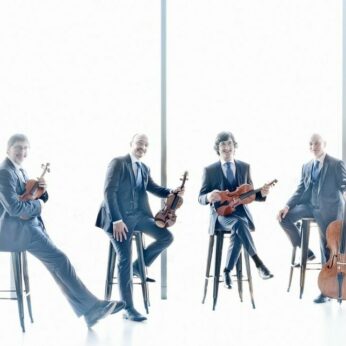Composer: Mieczyslaw Weinberg (b. 1919 - d. 1996)
Performance date: 29/06/2022
Venue: St. Brendan’s Church
Composition Year: 1957
Duration: 00:25:46
Recording Engineer: Simon Cullen, Ergodos
Instrumentation: 2vn, va, vc
Instrumentation Category:String Quartet
Artists:
Quatuor Danel (Marc Danel, Gilles Millet [violins], Vlad Bogdanas [viola], Yovan Markovitch [cello] -
[quartet]

Mieczysław Weinberg [1919-1996]
String Quartet No.7 in C major Op.59 [1957]
The ten year gap between Weinberg’s Sixth and Seventh Quartets is only partially explained by the notorious blacklist from the anti-formalist campaign of 1948, known ironically as the Zhdanov business after the apparatchik in charge. Unfortunately that was just the beginning, Weinberg’s father-in-law was Solomon Mikhoels, Artistic Director of the Moscow Jewish State Theatre and war-time leader of the highly successful Jewish Anti-Fascist Committee. He had a ‘road accident’ in 1949 on the direct orders of Stalin and for the next four years Weinberg was followed everywhere by NKVD agents, until Stalin’s final paranoid flourish, the so-called Doctor’s Plot, led to his arrest in early February1953
After his friend’s arrest Shostakovich wrote to the infamous NKVD chief Beriya vouching for Weinberg as an honest citizen and talented composer, whose only interest was in music. Shostakovich’s wife, Nina, even arranged for power of attorney so that they could look after Weinberg’s seven-year-old daughter if his wife was also arrested. Such actions were lunacy in those days, but Shostakovich insisted that the authorities could not touch him. Weinberg was saved by the death of Stalin and the two families celebrated with a dinner, where the power of attorney was symbolically burnt. Years later when Weinberg was relating the story of his arrest, he said it should not be published because everything might happen again, da capo. We are now living in that da capo time and the music of those who survived has a special resonance
Weinberg’s Jewishness and his Polish nationality meant he was always an outsider in the Composers’ Union, but he was held in high esteem by musicians. His work was performed by all the leading performers of the day – Oistrakh, Kogan, Rostropovich, Shafran, Gilels, Sanderling, Kondrashin, Rozdestvensky, Barshai and Svetlanov. Part of the difficulty of performing his works in the West was due to the difficulty of getting access to his scores. It remains extraordinary that such a major figure can have been ignored for so long. This was the first Weinberg Quartet to be played in Bantry back in 2001. The performers were the Dominant Quartet, students of Valentin Berlinsky, who was many times at the Festival.
The work begins with an achingly beautiful and consoling Adagio that will reappear in a different form at the opening of the last movement. The comparative calm is disturbed first by grim and threatening chords and later, in an inspired stroke, a cheeky figure that presages the material of the second movement. The massive chords are allowed to build into a powerful climax before the opening theme returns, allowing the movement to end peacefully. The delightful Allegretto cannot but make us wonder whether we have strayed into a rediscovered work by Shostakovich. With the two composers playing each of their latest compositions to each other, there was bound to be a certain exchange of ideas, there was certainly a huge amount of mutual respect. Weinberg’s ten year gap in quartet composition seems so far to have softened his edges. This movement became a favourite encore piece of the Borodin Quartet who premiered this and four later Weinberg Quartets.
The last movement is by any standards extraordinary. It is a palindromic set of variations that begins simply with a powerful theme related to the opening Adagio leading into a massive Allegro, whose intensity gradually overwhelms the work. It is effectively monothematic, exploring in a great arc the motif-like subject that twists and turns in its many guises, building to a monstrous and savage climax that could not have been predicted by what came before. As the climax subsides the variations repeat in reverse order with a long decrescendo that eventually fades back into the opening Adagio. This is no neat rounding off but another devastating outcry of a soul in pain ending with a shuddering chord dragged from the depths.
Francis Humphrys
Copyright © 2024 West Cork Music. All rights reserved.
Designed and developed by Matrix Internet